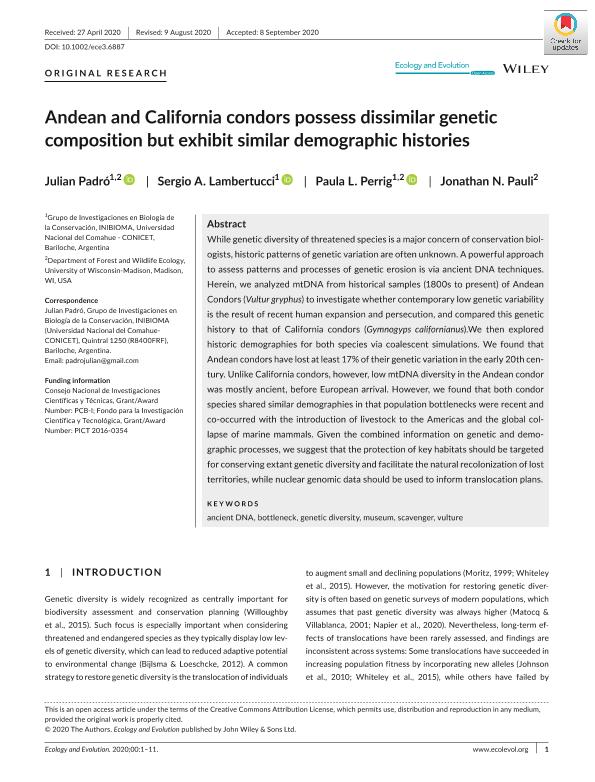Artículo
Andean and California condors possess dissimilar genetic composition but exhibit similar demographic histories
Fecha de publicación:
10/2020
Editorial:
John Wiley & Sons
Revista:
Ecology and Evolution
e-ISSN:
2045-7758
Idioma:
Inglés
Tipo de recurso:
Artículo publicado
Clasificación temática:
Resumen
While genetic diversity of threatened species is a major concern of conservation biologists, historic patterns of genetic variation are often unknown. A powerful approach to assess patterns and processes of genetic erosion is via ancient DNA techniques. Herein, we analyzed mtDNA from historical samples (1800s to present) of Andean Condors (Vultur gryphus) to investigate whether contemporary low genetic variability is the result of recent human expansion and persecution, and compared this genetic history to that of California condors (Gymnogyps californianus).We then explored historic demographies for both species via coalescent simulations. We found that Andean condors have lost at least 17% of their genetic variation in the early 20th century. Unlike California condors, however, low mtDNA diversity in the Andean condor was mostly ancient, before European arrival. However, we found that both condor species shared similar demographies in that population bottlenecks were recent and co-occurred with the introduction of livestock to the Americas and the global collapse of marine mammals. Given the combined information on genetic and demographic processes, we suggest that the protection of key habitats should be targeted for conserving extant genetic diversity and facilitate the natural recolonization of lost territories, while nuclear genomic data should be used to inform translocation plans.
Palabras clave:
ANCIENT DNA
,
BOTTLENECK
,
GENETIC DIVERSITY
,
MUSEUM
,
SCAVENGER
,
VULTURE
Archivos asociados
Licencia
Identificadores
Colecciones
Articulos(INIBIOMA)
Articulos de INST. DE INVEST.EN BIODIVERSIDAD Y MEDIOAMBIENTE
Articulos de INST. DE INVEST.EN BIODIVERSIDAD Y MEDIOAMBIENTE
Citación
Padró, Julian; Lambertucci, Sergio Agustin; Perrig, Paula Leticia; Pauli, Jonathan Nicholas; Andean and California condors possess dissimilar genetic composition but exhibit similar demographic histories; John Wiley & Sons; Ecology and Evolution; 10; 23; 10-2020; 13011-13021
Compartir
Altmétricas




